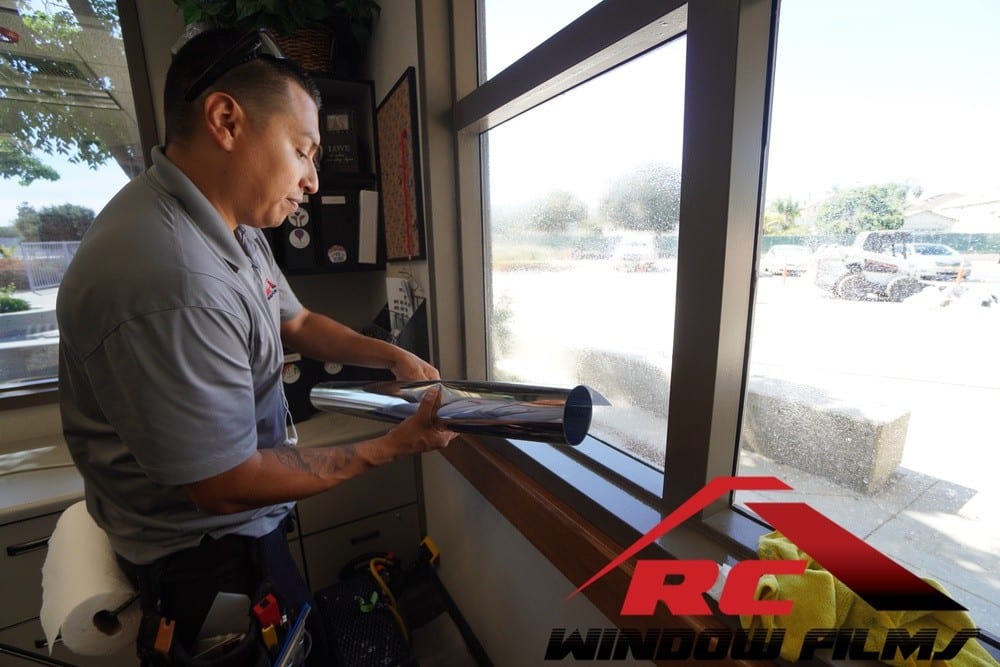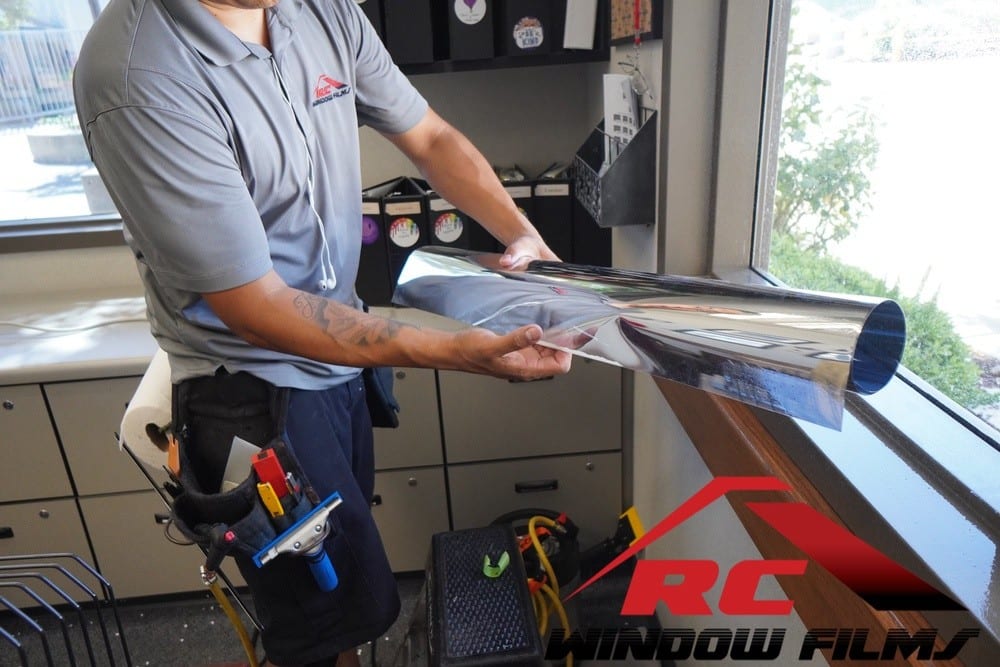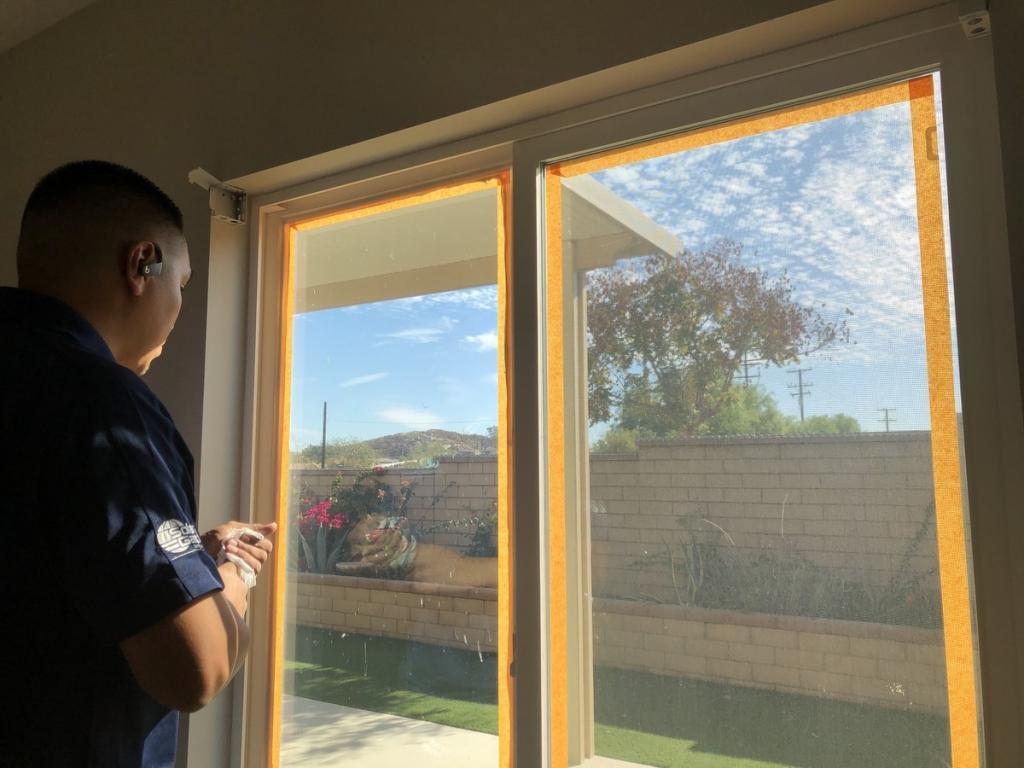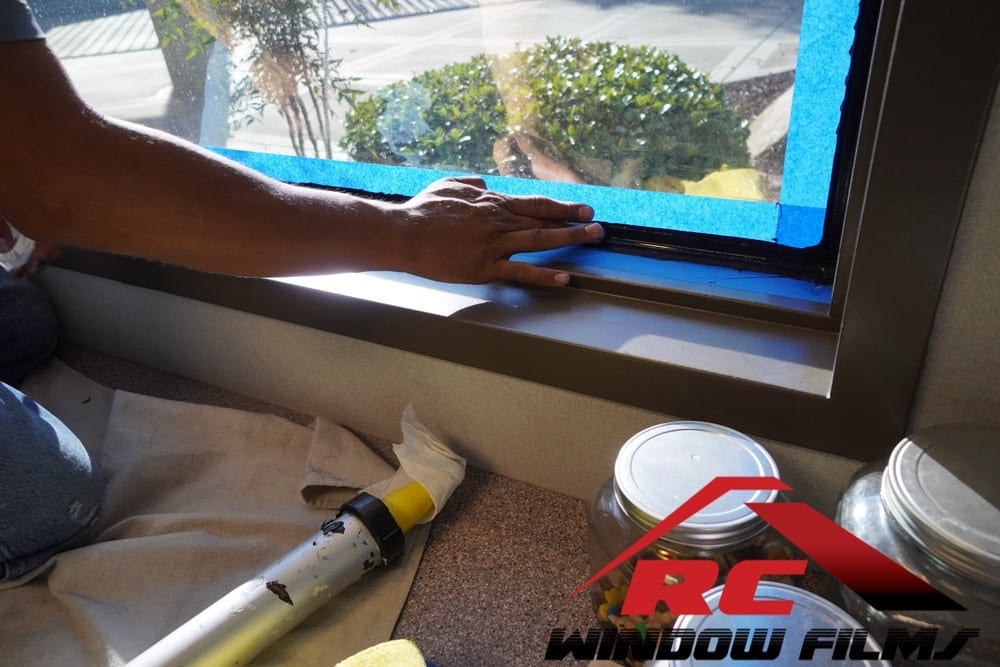The best type of security film is dependent on the kind of protection desired. Generally, the thicker the film, the stronger it is.
When considering Security window film, it’s essential to examine the thickness of the glass itself and the frame it’s secured within.
The thickness of the glass and the framing system is an integral part of the security retrofit and plays a significant role in the strength and durability of Security window film installation.

Security window film installation
This article will outline:
- How security film manufactured
- Guide you in identifying the proper film-to-glass treatment
- Discuss treatment on the dual-pane glass
- Review the types of anchoring systems
- Provide an overview of the installation process
- Give you an estimated installation cost
What is Security Window Film?
Security film is a thick multi-laminated plastic film made of special acrylic adhesives. This film is designed to absorb impact and disperse impact for blast mitigation and added security.
In 1969 manufacturers of plastic materials such as 3m Safety also known as 3m window film and their ultra series ( Minnesota Mining and Manufacturing Company), and others began introducing thick multi-layer transparent films for added protection for glazing walls and windows and glass doors.
The invention of this product came about after several embassy bombings in Europe, America, and around the world.
After these various bombings, including the Alfred P. Murrah building bombing in 1995 in Oklahoma, the GSA set bomb blast standards for security film and glass to mitigate the lethal effects of blast fragmentation during a blast event. The GSA took note of notices of glass damage as far as 15 blocks away.
The film’s initial purpose was to protect occupants from flying debris caused by events such as bombings, natural disasters, and other scenarios. Window Protection films are designed to protect commercial buildings and critical infrastructures such as airports, transportation venues, government facilities, and other buildings vulnerable to attack.
Unlike other window tinting films such as decorative window film, sun control, and other polyester film products familiar to the general public, security window films are generally undetectable to the naked eye and specifically designed to prevent break-ins, vandalism, glass breakage and bomb blast mitigation by preventing glass shards, broken glass, or shattered glass from becoming projectiles in the event of a blast.
Window films for security also come with solar control components. They combine solar control with security, the benefit of security, heat reduction, UV protection, daytime privacy, glare reduction, and reducing the building’s energy consumption, reducing the building’s carbon footprint and sometimes leading to payback in as little as possible 5-7 years.
Since the start of window protection films, many governments, corporations, schools, and even homes have experienced the added safety and peace of mind security films, offer to protect people and valuables.
Window Protection films are impact-resistant, making them ideal retrofits to fortify glass by adding a layer of protection. Security films offer occupants added protection from flying debris, lend time to first responders in the event of natural disaster or bombing, and even slow the efforts of unwanted intruders from gaining access to buildings or homes.

Privacy Security Film
How is Security Film Made?
Like many products we use today, the raw material required for security film is crude oil. Window film manufacturing starts by distilling crude oil and producing polyester.
Polyester (PET) is also the primary component of all window films. Polyester is the outcome of the Extrusion process of crude oil. The refining of crude oil is a process known as Extrusion.
After Extrusion, Manufactures send raw polyester to the second phase of production. The second phase of manufacturing is the lamination phase.
In the second phase, dyes, adhesives, hard coats, and release liners are added, completing the window film production process. This details the primary method of constructing all window films.
Yet, with concern to security film, special acrylic adhesives are added to strengthen the lamination and the bond to the glass. A unique pressure-sensitive adhesive that’s 7-10 times stronger per square inch is used, unlike the 1-2 lbs per square inch found in solar control films, anti-graffiti films, and others.
The pressure-sensitive adhesive is also treated with UV inhibitors to prolong the film’s life and protect the occupants and furnishings from harmful UV rays.

Security films manufacturing
Does Security window Film go on dual pane windows?
Window film installation of security window film on dual pane windows is safe and helps fortify the glass.
The use of window protection film on dual pane windows is only hindered by the window frames themself. Glass Window frames are usually wood, vinyl, or metal. Each window framing system has limitations regarding impact resistance and strength.
- Vinyl frames are pretty weak as far as a material, they are great for longevity, but it’s not the ideal frame for security.
- Wooden window frames are much stronger than vinyl and provide much more rigidity and security when compared to vinyl.
- Metal frames are the ideal framing system to apply security window film. The metal has a very high tensile strength and is often the most robust material for window and door frames in the glazing industry.
Depending on the level of security, desired security films come in the following thicknesses, and these numbers can be different depending on the manufacturer.
Thicknesses found in the Security Window Film Line up and Primary Use:
- Four mils (4) – Low-Security primary use is to retain glass and bring old Glazing to code, common for bathroom windows that are not tempered, doors, sidelights, and transoms.
- Six mils (6) – Medium-Security used is to retain glass and bring old Glazing to code, common for bathroom windows that are not tempered, doors, sidelights, and transoms.
- Seven mils (7) Medium-Security used is to retain glass and bring old Glazing to code, common for bathroom windows that are not tempered, doors, sidelights, and transoms.
- Eight mil (8) (most common) High-Level Security GSA-approved Blast proofing film meets all bomb blast and intruder delay requirements.
- Ten mils (10) High-Level Security (Exceeds) GSA-approved Blast proofing standards and meets all intruder delay conditions
- Eleven mils (11 )High-Level Security (Exceeds) GSA-approved Blast proofing standards and meets all intruder delay conditions
- Twelve mils (12) High-Level Security (Exceeds) GSA-approved Blast proofing standards and meets all intruder delay conditions
- Fourteen mils (14) High-Level Security (Exceeds) GSA-approved Blast proofing standards and meets all intruder delay conditions
- Fifteen mils (15) High-Level Security (Exceeds) GSA-approved Blast proofing standards and meets all intruder delay conditions
The thickness of the film is necessary but making sure to install the film on a framing system that can handle the potential load is essential as your efforts are limited by the glass and framing system.
An ideal situation where film application is most secure is on metal-framed windows and doors. Combining a metal frame and commercial tempered glass with no less than an eight (8) mil thick film is a GSA standard and well-tested solution for blast mitigation and intruder deterrence.
Testing Standards our Security System Films have passed –
Level of protection:
- ASTM, E1886, E1996 (Hurricane)
- ASTM E84 – Flame and smoke generation
- ANSI Z97.1 and CPSC 16 CFR 1201 – Human impact
- GSA TS01-2003 – Bomb blast
- ASTM 1642-04 – Bomb blast
- ISO 16933 – Bomb blast
- EN 12600 – Human impact & burglar prevention film
- EN 356 – Burglary resistance.

Installing security window film at a home
What makes Security Films different from Solar Control Films?
Security window film stops delays break-ins, provides shelter during windstorms, severe weather, and adds to home security and building security. Whereas solar control films are for those trying to reduce heat, glare adds privacy.
During the second phase of manufacturing, security films are layered and laminated several times beyond conventional films. This fact is evident in the thicknesses of the films when compared. Solar control films are 1-2 millimeters thick. But, security films range from 4-to 24 millimeters thick.
The multi-layering of window protection film makes it very thick but maintains clarity, producing a dense and impact-resistant material. This process sometimes includes adding solar control components such as aluminum and other metals for added solar control capabilities.
But, unlike standard solar control films, security films must be attached to the glass frame; attaching the film to the window’s structure is also known as anchoring.
While the special adhesives and multilayered construction of protection window film make it steadfast and impact-resistant, it is only as strong as the tensile strength of the glass surface if not attached to the frame.
Best Impact Protection Attachment Systems?
The most common and best solution is wet Glazing. It’s fast, super strong, and looks great when applied by a professional company.
Anchoring systems are an essential part of security film application; without an anchoring system, the security film is only as strong as the glass; security film will hold the glass together and fall to the ground or become a projectile.
Anchoring systems are simple, and there are three primary methods of application.
- Wet Glazing is a structural silicone caulking applied wet and tooled to look like an extruded gasket.
- Pentagon protection systems – This stick-on solution uses 3m VHB tape to secure the glass to a window frame.
- Screwed Mechanical – This is where security film is cut long and screwed into a window or door frame to use the film’s strength as the anchor.
While you may have several choices when anchoring security film, it all comes down to the desired specification and what you want it to look like a completion.
The cost for each system differs and is as follows when it comes to cost:
- The lowest price is wet glazing attachment, but it’s challenging to do well; experienced calking professionals are costly (this is an art).
- Cost ranges from $5-$8 a linear Foot of Caulking.
-
Pentagon protection systems – look excellent, and you only get one shot at doing it well, and that’s where the cost adds up.
- Cost ranges from $6-$10 a linear foot.
- The Screwed Mechanical requires more material and planning. Also, an appealing aesthetic outcome can be challenging to achieve using this method of the anchoring system.
- Cost ranges from $2-$12 a linear Foot of Caulking.
- This cost varies as there are many different ways to complete this system. Raw materials can range in price, which is hard to assess cost without knowing the desired result.

Security film installation of dow corning 995 attachment system for anchoring
How is Safety and Security window film installed?
- Security film is applied using a wet application process, and the glass is cleaned by scraping contaminants off with a stainless steel blade or scotch bright scrubby pad to prepare the glass for installation. The glass is then dried to perfection with a low or no lint cloth to cut the chance of debris left behind.
- After the cleaning and prepping process, window film is cut to the exact size on a Film-handler or CNC cut in the shop before the installation day.
- In the diagram below, each panel is applied using a 15-inch squeegee following the squeegee application method.
- After the film is applied, it’s given one more cleaning with a soapy solution or sprays away.
- The curing time starts now, generally, and depending on weather conditions, thick materials need 30-100 days to cure fully.
- After the film has cured, your choice of attachment system needs to be applied to secure the film to the glass frame.
According to the GSA, security window film is worthless without an attachment.
As discussed above, Window film Contractors will generally apply one of the following anchoring materials:
- Wet Glazing Silicone – Dow Corning 995 or 3M Impact Protection Attachment Sealant
- Pentagon Protection Systems (PPS) – A double-sided adhesive rubber attachment system, this anchoring system comes in various colors and thicknesses.
- Screwed Mechanical – this is a security retrofit and is often specified by an architect or engineer.
Application of attachment system:
Now that your film is cured, it’s time to apply the attachment system.
-
Wet glazing attachment system Installation Process:
- Use 70% isopropyl alcohol to clean the window frame and the film where the wet glazing caulking is applied.
- Mask off the film and window frame using 3M Blue masking tape to ensure clean straight lines 1/2 inch wide from the edge and window, creating a 1-inch thick caulking bead.
- Apply the silicone structural sealant and tool it, guaranteeing an even 45-degree angle from the frame and window for maximum coverage.
- Remove the tape and allow the caulking to cure for 3-5 days.
-
Pentagon Protection Systems (PPS) Installation Process:
- Use 70% isopropyl alcohol to clean the window frame and the film where the system is applied. In cold temperatures, use the 4298 adhesive promoters.
- Use precise instruments to apply adequate and constant pressure to achieve total adhesion.
- Be sure that the film edges, gasket, and frame are dry if installing the anchoring.
- Do not touch the bare tape to anything.
- Before installing the (PPS), verify that the film edge clearance to the gasket is 1/8″ maximum.
-
Screwed Mechanical System Installation Process:
- Use a metal angled frame, which is screwed into the glass window frames or the building wall.
- The film is installed “oversized” to allow a wrap under the metal frame. Screws are placed through the film and the anchoring frame for a strong bond.
- Screwed Mechanical systems are a robust system because of the wrap of the film under the anchoring frame, and the screws increase the anchorage of the structure to the building, significantly increasing protection.
- Drawbacks include high cost and the permanent nature of the installation; if you ever want to remove the anchoring system, the frames will have holes displayed.
How much is shatterproof window film attachment system?
Cost depends on the thickness and the type of anchoring system used to secure the film to the window frame. Keep in mind that branding is an essential cost factor as well. Some well-known companies demand a higher application cost; but, the added cost isn’t all that justified unless the warranty is greater than the following competitor.
What you can expect to pay:
- Security Film Installation Cost: $9-15 a square foot.
- Attachment Installation Cost: $5-$15 a linear foot
Home window protection film
Security window films can also be used in homes. Homeowners around the united states have found peace and comfort by adding security window film to fortify their homes and make them more secure.
Several types of thickness can be used on homes, but the most common security window film is an eight mil thick film. This thickness seems to be a sweet spot for most homes based on standard glass.
There are also privacy security films that are silver in a tone that gives you security and privacy.
We hope you enjoyed learning about Security Window Film. Here at RC Window Films, we will continue to learn and grow with our customers to bring you the most up-to-date information continually.
If you are interested in getting Protection Film, don’t hesitate to contact us!

